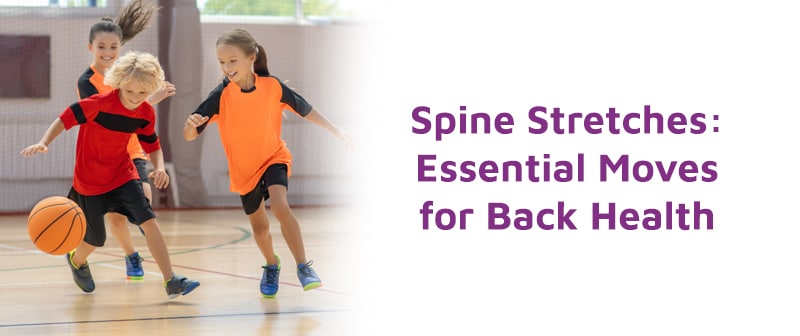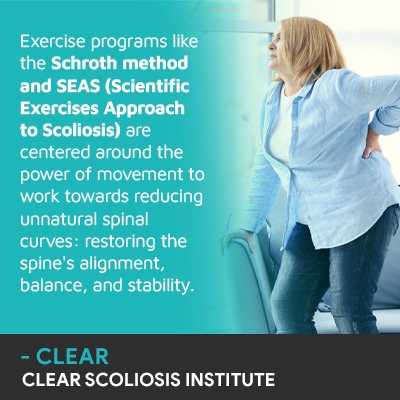
Most people will deal with back pain at some point in their lives. Back pain can be caused by a number of reasons including a stiff spine, weak surrounding muscles, an underlying spinal condition, injury, and more. While some spinal conditions, like scoliosis, can't be prevented, practicing a spine-friendly lifestyle means staying active and maintaining spinal strength and flexibility; regular stretching can help.
Regular stretching is essential for maintaining back health and function. Stretching the back doesn't just stretch the spine, but also its surrounding muscles, tendons, and ligaments. Spine stretches can also be therapeutic and help address a number of spinal conditions/issues.
To better understand spinal health, let's explore the spine's basic structure.
A healthy spine is one that's strong, flexible, and has its natural curves in place.
The main spinal sections include the cervical spine, thoracic spine, and the lumbar spine.
The spine is curved at each of its main sections, and these curves make the spine stronger, more flexible, and better able to handle mechanical stress from movement and impact.
As a complex structure with many moving parts, the parts work together, and the health of each spinal section is affected by the other spinal sections.
The spine consists of vertebrae (bones) that are stacked on top of one another, and if the spine's healthy curves are in place, the vertebral bodies are aligned, and the spine is held in a straight and balanced position.
Adjacent vertebral bodies are separated by an intervertebral disc, and the health of the spine is directly related to the health of its discs.
The health of the spine, however, doesn't just involve the spine, but also the health of its surroundings.
The spine needs to be surrounded by strong muscles for support and stability, and exercises and stretches can be an important part of keeping muscles healthy, along with keeping the spine itself strong and flexible.
As the spine's design is movement-based, finding a balanced activity level will help keep the spine and its parts healthy.
A spine that's healthy is one that's flexible with a wide range of motion.
Over time, and with aging, the spine can lose some of its flexibility and strength, and while there is a certain amount of spinal degeneration that's expected with age, there are lifestyle choices and habits that also play a role.
Stretching and movement can help increase space within the spine, counteracting compression (decompression), and taking pressure off the spinal discs.
As the discs don't have their own vascular supply, increasing circulation through exercise and stretching makes nutrients and oxygen, needed for disc health, more readily available to the discs through osmosis.
Stretches that take pressure off a compressed disc can provide pain relief and help the discs stay hydrated.
Degenerative disc disease is linked with the development of several spinal conditions/issues.
Bones are living tissue, consisting of bone cells, minerals like calcium, and connective tissue.
The bones of the spine can benefit from stretching and exercising just like the rest of the body's bones.
Stretching can help keep bones healthy by improving blood flow so oxygen and nutrients are available to help the bones grow and repair.
Stretching the back can help keep the spine flexible, making it less vulnerable to injury and strain.

Spinal conditions like scoliosis that cause an unnatural sideways spinal curvature and vertebral rotation can cause the spine to become increasingly rigid, making it less responsive to treatment, which is why physical therapy is so important in non-surgical scoliosis treatment.
Exercise programs like the Schroth method and SEAS (Scientific Exercises Approach to Scoliosis) are centered around the power of movement to work towards reducing unnatural spinal curves: restoring the spine's alignment, balance, and stability.
It's important to understand that an exercise-based approach to treating scoliosis will include stretches and exercises that are scoliosis-specific and have to be approved by a patient's treatment provider.
Following are some stretches commonly recommended for maintaining overall spinal health and function.
A chin to chest stretch can help relieve a tight neck and reduce neck pain by keeping the cervical spine strong, flexible, and maintaining its natural and healthy curve (lordosis).
Regular stretching can also help maintain proper posture: key for spinal health.
The neck, especially, is vulnerable to modern technology usage issues, such as tech neck and forward head posture.
Chronic poor posture and looking down at devices for extended periods of time introduces adverse spinal tension, can cause uneven wear and tear, pain and stiffness.
A chin to chest stretch can be performed by:
Performing a chin to chest stretch can help release tension in the neck and shoulders, and this can also help the neck support the weight of the head and maintain the neck's range of motion.
Now, to counteract the potential of a chin-to-chest stretch to increase forward head translation, the stretch should be followed by a cervical extension and posterior head translation exercise.
Performing a posterior cervical translation stretch can help counteract forward head posture by lengthening the back of the neck, and this facilitates the head’s alignment over the neck, and the neck’s alignment with the rest of the spine.
A posterior cervical translation stretch can be performed by:
The latissimus dorsi is a large flat back muscle and is the widest muscle, covering most of the lower and middle back muscles.
This muscle controls upper body movement.
A latissimus dorsi stretch can be performed by:
Keeping the core muscles strong can help reduce muscle tension and pain and facilitates a wide range of movement.

The lumbar spine is vulnerable to pain and injury because of its flexibility and strength; it has to support a significant amount of the body's total weight.
The vertebrae of the lumbar spine have to be strong to support the weight of the spinal sections above, the trunk, and they feel the affect and potential strain of complex movements like bends, twists, and lifts.
A pelvic tilt can be performed by:
As one long structure, the health of each spinal section affects the entire spine and the ability of its sections to function well together: biomechanics.
Stretches that target one specific section of the spine don't just improve the health and range of motion in that singular spinal section, but can improve the health of the entire spine and its surroundings.
Spine stretches that are performed correctly and regularly can help maintain spinal flexibility, range of motion, core and back muscle strength, and improve posture.
When treating spinal conditions like scoliosis, specific customized stretches and exercises can help in a number of ways: pain relief, making the spine more flexible and responsive to treatment, preserving range of motion, keeping the core strong for more spinal support and stability, and facilitating postural awareness and remodeling.
Spine stretches such as the chin to chest, latissimus dorsi stretches, and the pelvic tilt can help keep the muscles that support the spine strong and balanced, and can help with pain relief and releasing tension.
Strained, sore, and unbalanced muscles can be painful, and they can also mean less support for the spine, leading to a number of potential issues, including making the spine more vulnerable to injury.
When it comes to conditions like scoliosis that cause a loss of the spine's healthy curves, a scoliosis-specific health care team and physical therapist can recommend specific stretches and exercises that can address symptoms of scoliosis, such as pain and increasing spinal rigidity, but also have corrective potential to improve the spine's alignment and restore healthy spinal curves.
Exercise-based treatment approaches such as the Schroth method and SEAS are invaluable, addressing unnatural spinal curves and back pain in a number of ways.
Here at the CLEAR Scoliosis Institute, when it comes to addressing spinal conditions like scoliosis, we rely on the power of movement to complement additional treatment disciplines (chiropractic, scoliosis bracing, and rehabilitation) with therapeutic and corrective potential.

CLEAR provides a unique and innovative way of understanding scoliosis. Sign up to receive facts and information you won’t find anywhere else.
